您的购物车目前是空的!
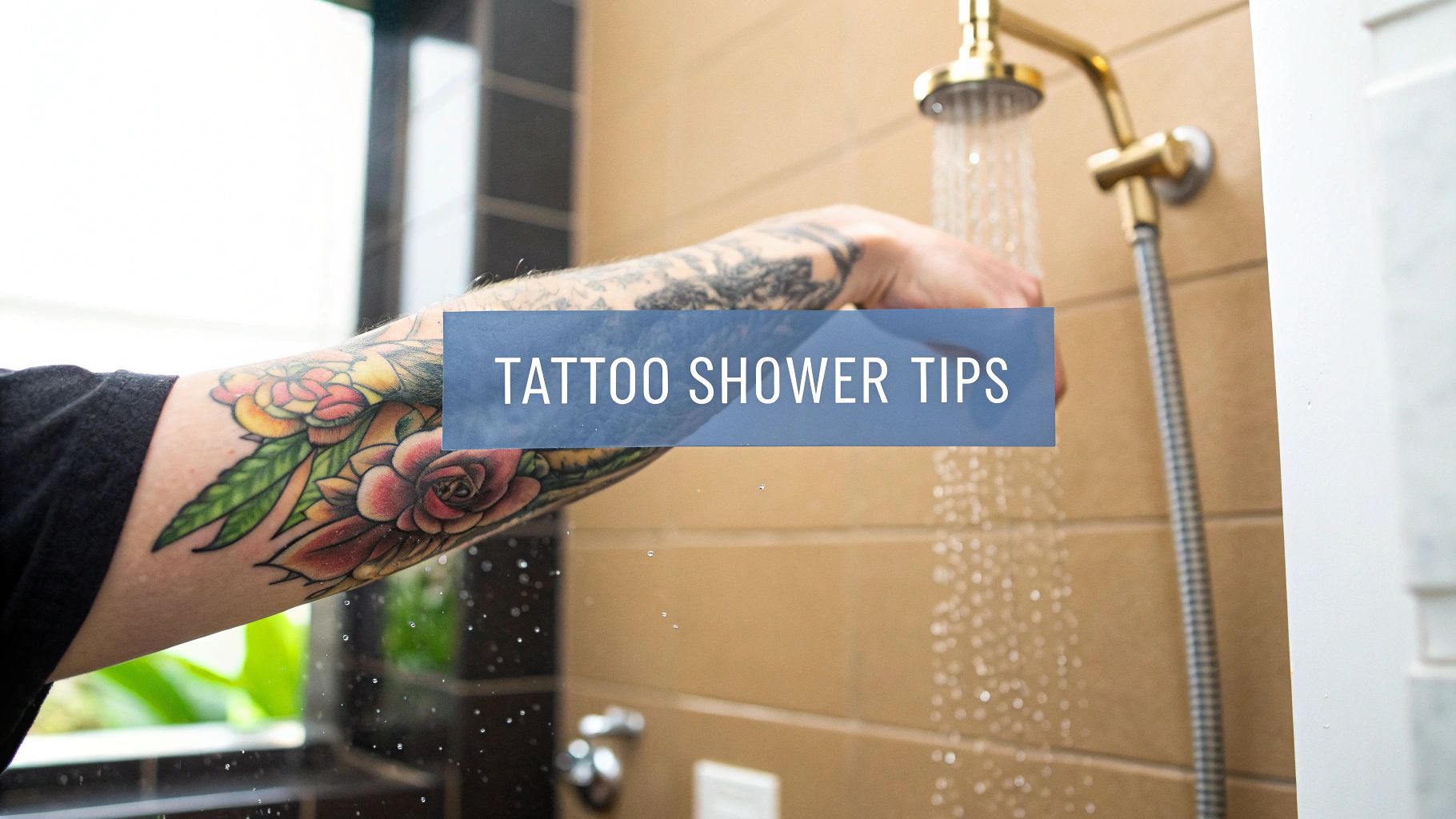
Can You Take a Shower After Getting a Tattoo? Essential Tips
Of course, you can shower after getting a tattoo. Anyone who tells you otherwise is missing the point. The real secret isn't if you can shower, but how and when you do it. It all comes down to timing and technique to protect that fresh ink.
The First Shower: Your Initial 24-Hour Guide
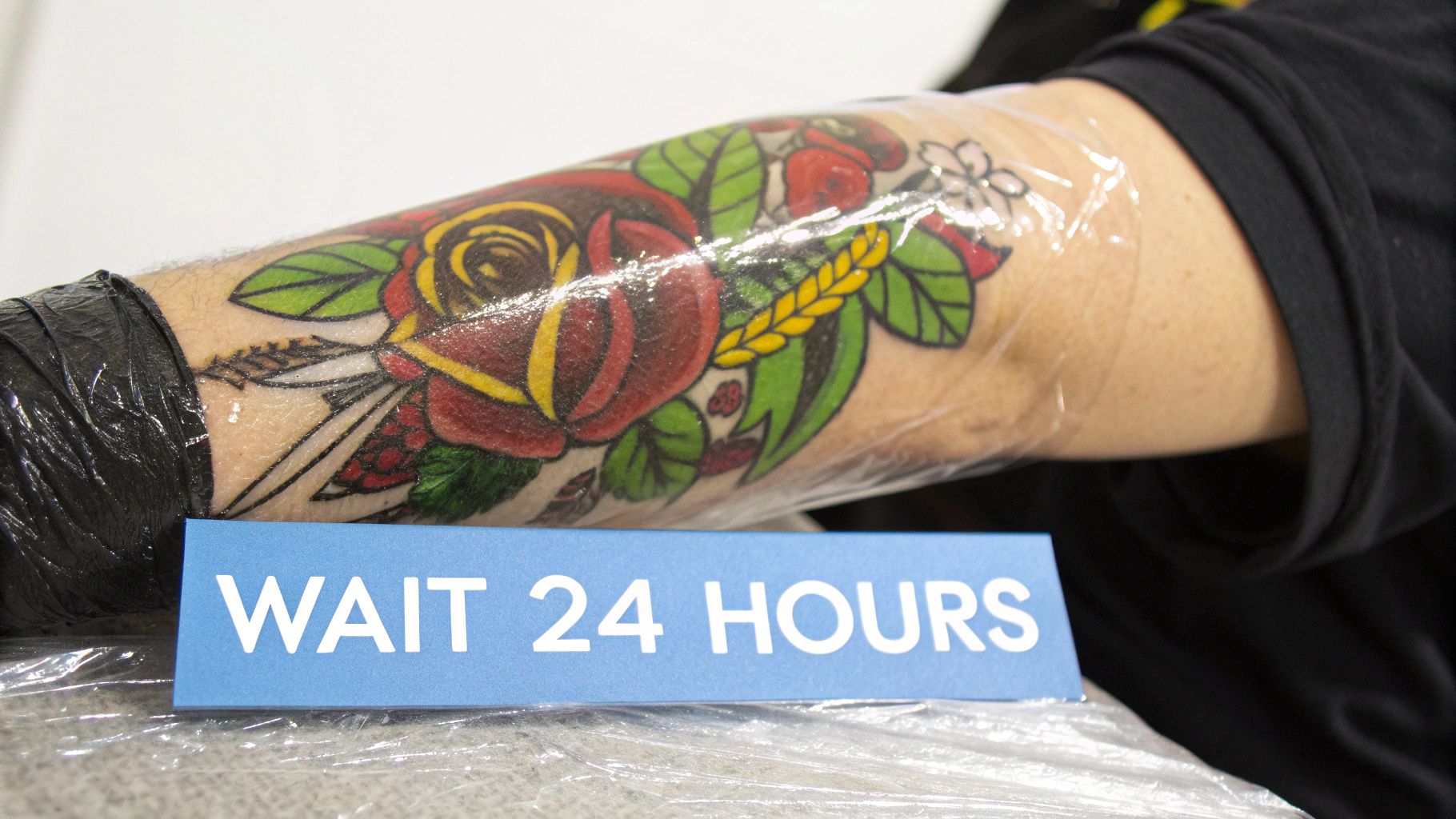
That first shower can feel a little nerve-wracking, but it's a critical part of the healing process. Don't overthink it. Just remember that your new tattoo is essentially an open wound—a very cool, artistic one, but a wound nonetheless. Like any scrape, it needs to be kept clean to heal properly and avoid any issues. Your main goal in these first 24 hours is simple: keep bacteria out and avoid irritating the skin.
The Waiting Game: Why It Matters
That waiting period your artist gave you isn't just a suggestion; it's rooted in how your skin actually heals. A tattoo machine creates thousands of tiny punctures, leaving your skin wide open and vulnerable.
Most experts and seasoned tattoo artists will tell you to wait at least 4 hours, but pushing it to a full 24 hours is often the gold standard. This pause gives your body a crucial head start. It allows the skin to start sealing itself off from bacteria and other irritants. If you jump in the shower too soon, you risk infection or even messing with how the ink settles into your skin. For a deeper dive into aftercare timing, the folks at Aquabliss have some great insights.
Key Takeaway: That initial 4-24 hour wait is your tattoo's first line of defense. It lets your skin's natural healing kick in, seriously cutting down the risk of infection and paving the way for a sharp, vibrant tattoo.
To cut through the noise, here's a quick rundown for that all-important first wash. Think of it as your cheat sheet to getting it right without any stress.
First Shower After Tattoo Quick Guide
| Action | Recommendation | Why It Matters |
|---|---|---|
| Wait Before Washing | Wait at least 4-24 hours as advised by your artist. | Gives skin time to start sealing, which is key to preventing infection. |
| Water Temperature | Use lukewarm water. Absolutely no hot showers. | Hot water can open your pores, causing irritation and potential ink loss. |
| Water Pressure | Keep the tattoo out of the direct, high-pressure stream. | A strong spray is painful on a fresh tattoo and can damage the fragile skin. |
| Soaking | Keep showers short (5-10 minutes). No baths or long soaks. | Soaking can soften scabs too early, which can literally pull the ink out. |
Following these simple rules for the first shower sets the stage for a smooth healing process. Keep it quick, keep it clean, and keep it gentle. Your new artwork will thank you for it.
How to Shower Safely With a New Tattoo
Stepping into that first shower with fresh ink can definitely feel a bit nerve-wracking. I get it. But with a few simple rules, the whole process is completely safe and won't mess with your new art. It’s all about being gentle and smart to protect both your skin and the tattoo underneath.
First things first, let's talk water. You’ll want to keep it lukewarm, not hot. Steamy, hot water can open up your pores, which might lead to irritation or, even worse, cause the ink to bleed or look faded before its time.
Next up is water pressure. The last thing you want is a high-pressure jet blasting directly onto your new tattoo. If you’ve got a detachable showerhead, now’s the time to use it for total control. No detachable head? No problem. Just use your body to shield the tattooed area from the direct spray.
Washing and Rinsing Technique
How you wash the tattoo is just as critical as the water itself. For now, forget about your loofah, washcloth, or any kind of exfoliating scrub. Those are way too harsh for healing skin and can be a breeding ground for bacteria.
Instead, you'll only use the clean tips of your fingers. Squeeze a small amount of mild, fragrance-free soap onto your hand and gently wash the area in a slow, circular motion. You're not trying to scrub it raw; you're just cleaning off any leftover plasma, blood, or ointment.
When it's time to rinse, let the water flow indirectly over the tattoo. For example, if the ink is on your forearm, let the water hit your shoulder and just run down over it naturally.
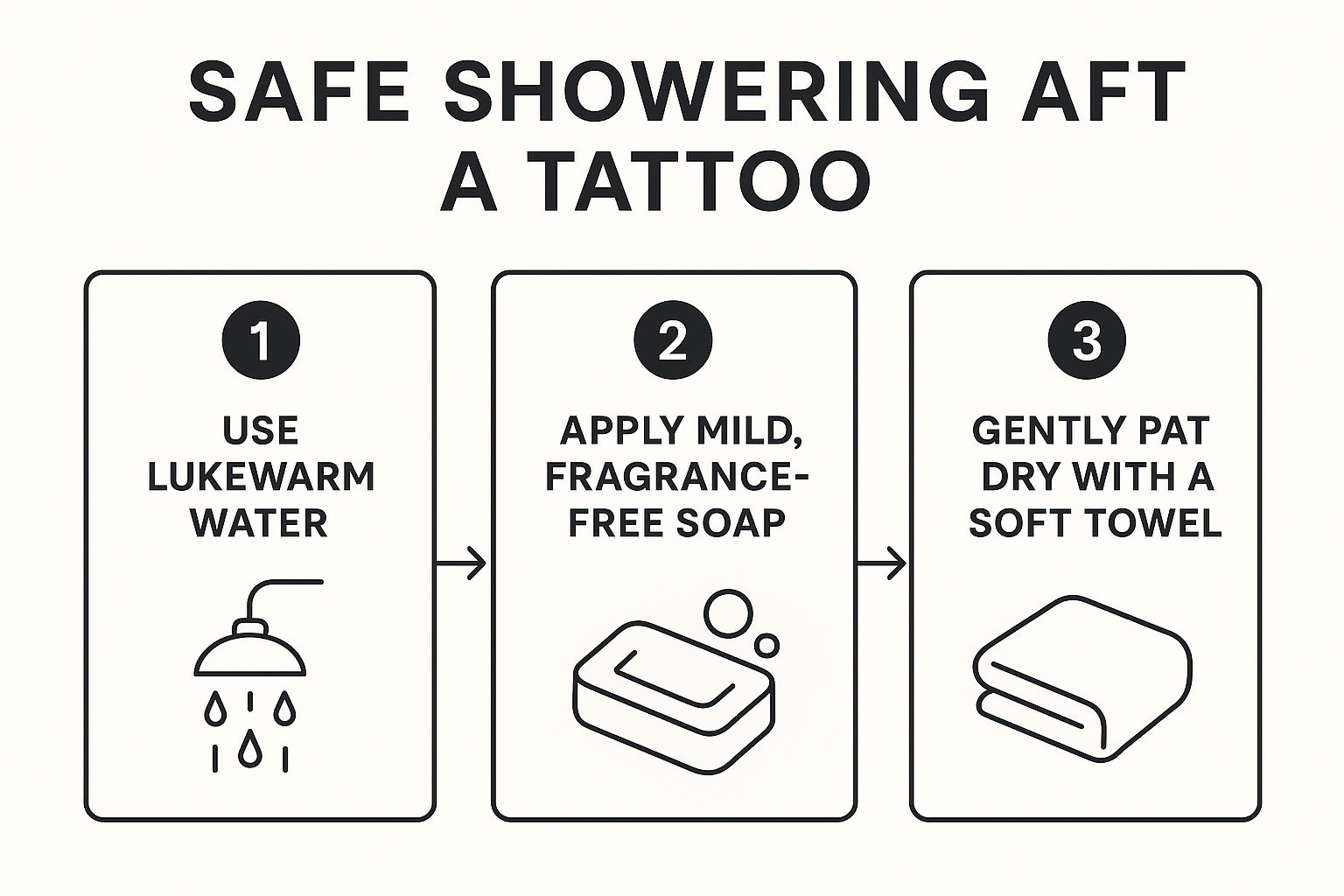
This simple routine is built on three key pillars: gentle temperature, proper cleansing, and careful drying. Master these, and you're golden.
The Critical Final Step: Drying Off
Once you’re out of the shower, fight the urge to reach for your usual bath towel. Even clean ones can hold onto bacteria and, more annoyingly, leave behind tiny fibers (lint) that can get stuck in your healing tattoo and potentially cause an infection.
Pro Tip: The best way to dry your new tattoo is with a fresh, clean paper towel. Gently pat the area dry—don’t rub or wipe it. A light patting motion is all it takes to soak up the moisture without irritating the skin. Let it air dry for another 5-10 minutes before you put on any aftercare lotion.
If you're wondering when you can get back to your normal, carefree shower routine, check out our complete guide on how long after a tattoo you can shower normally.
Choosing the Right Cleansers and Lotions
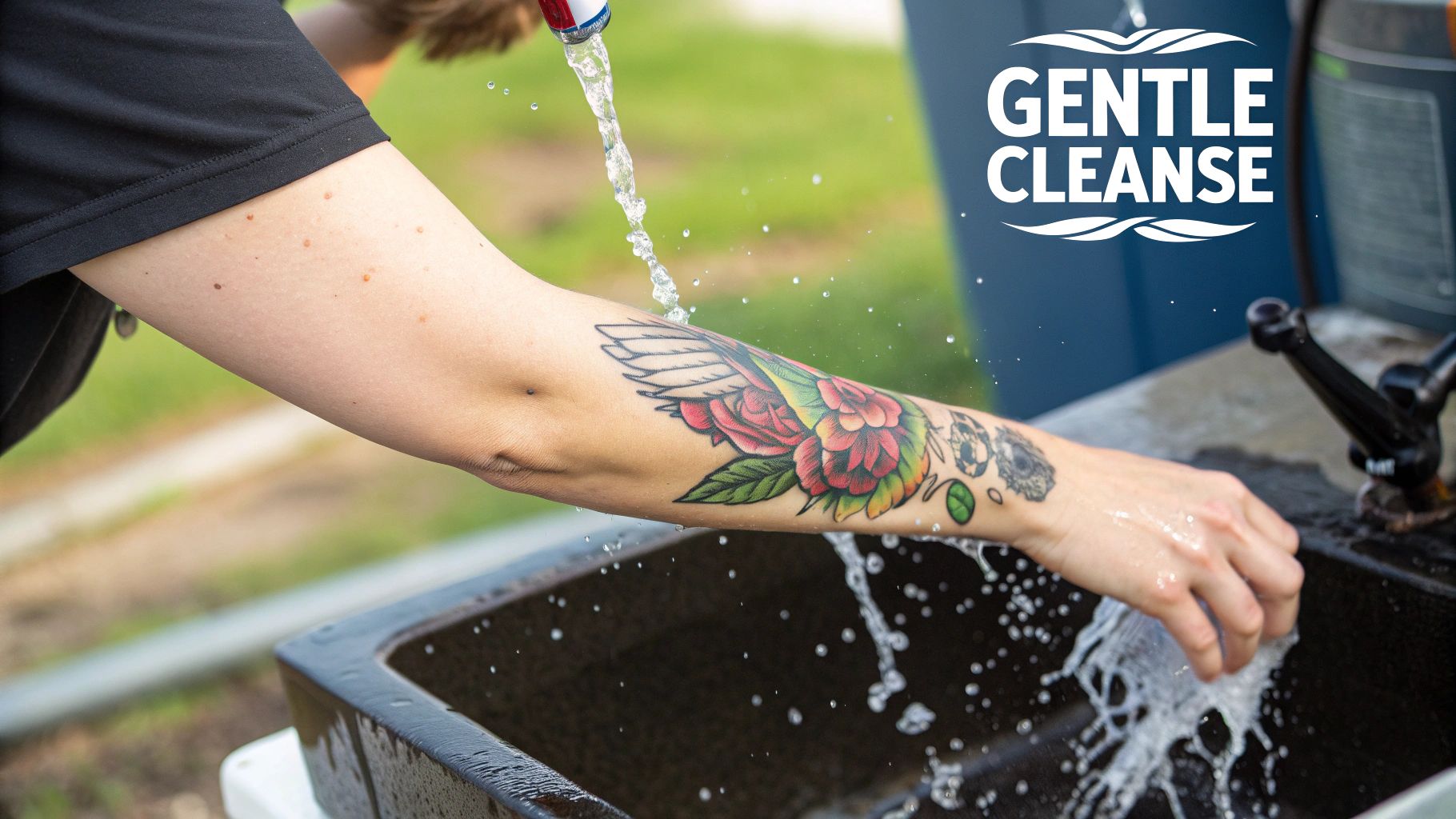
What you put on your new tattoo is just as important as how you wash it. The soap aisle can be overwhelming, but your mission is simple: find the mildest, gentlest cleanser on the shelf. You have to treat your new tattoo like highly sensitive skin right now—because that's exactly what it is.
Your new best friend is a mild, fragrance-free antibacterial soap. Harsh chemicals, heavy perfumes, and dyes found in a lot of standard body washes can cause some serious problems. We're talking allergic reactions, redness, intense itching, or even causing your fresh ink to fade. Your healing skin just doesn't need that extra stress. Look for labels that say “hypoallergenic” or “for sensitive skin.”
What to Avoid in a Cleanser
You'll want to steer clear of anything with harsh ingredients. These are the top offenders that can completely derail your healing process:
- Exfoliants: Any scrubs with beads or alpha-hydroxy acids are a definite no-go. They'll just tear up the delicate new skin and can literally pull ink out.
- Heavy Fragrances: Perfumes are a huge source of skin irritation and can easily trigger allergic contact dermatitis.
- Dyes: Artificial colors do absolutely nothing for your skin and are just another potential irritant.
A simple rule of thumb I've always followed: if you wouldn't use it on a baby's skin, don't put it on your new tattoo. Keeping your product list minimal and gentle is the secret to a healing journey without complications.
The Post-Shower Moisturizing Step
After you've gently patted your tattoo completely dry with a clean paper towel, the next move is hydration. Don't rush this. Applying lotion to skin that's still damp can trap moisture, which is a recipe for irritation and other issues. For more in-depth details on the timing of that first wash, you can read our guide on how long after a tattoo you can shower.
Once it's bone dry, go ahead and apply a whisper-thin layer of a recommended tattoo aftercare product. Over-moisturizing is a really common mistake that can clog your pores and suffocate the tattoo. You want to use just enough to give the skin a slight shine, keeping it hydrated without feeling greasy or smothered.
Common Showering Mistakes That Can Ruin Your Ink
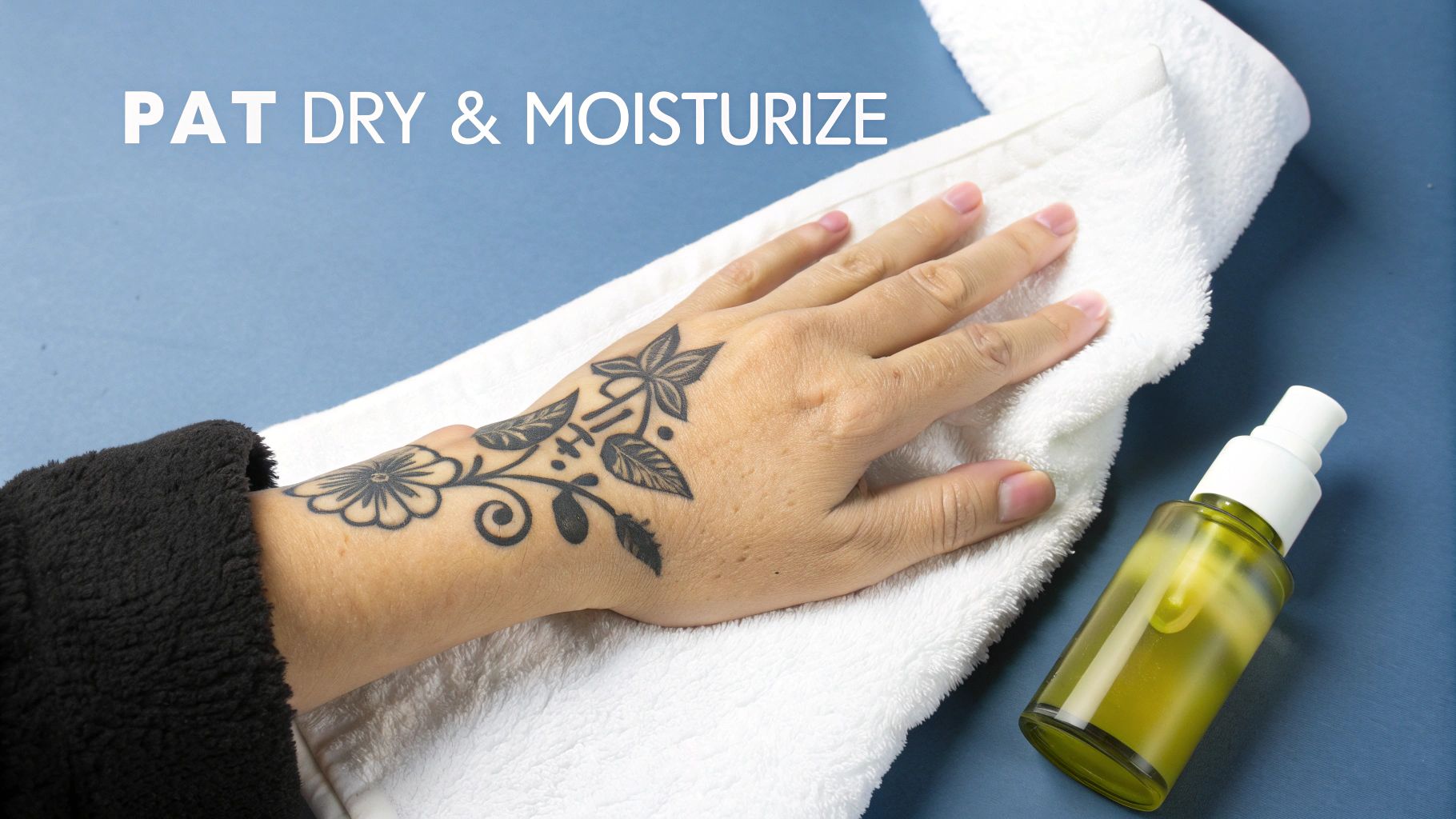
Sometimes, knowing what not to do is the most valuable advice. Tattoo aftercare is mostly common sense, but a few simple missteps in the shower can quickly put your new art in jeopardy. Even with the best intentions, it’s all too easy to slip into old habits that can seriously harm your healing skin.
The absolute biggest mistake is over-saturating the tattoo. This is what happens when you take those marathon-long showers or just let the water run over your new ink for too long. Think of it this way: your tattoo is protected by a delicate shield of scabs that are just starting to form. Soaking them turns that shield into a soft, mushy mess that can slough right off, taking precious ink along with it.
Industry surveys have shown that when aftercare goes wrong, nearly 30-40% of new tattoos face healing issues, and this is a major one.
The "Avoid at All Costs" Playbook
Beyond just soaking it, a few other common shower habits can turn your healing journey into a nightmare. These are the top mistakes tattoo artists constantly warn their clients about:
- Cranking Up the Heat: Scalding hot water feels good, but it opens your pores and can cause extra swelling and irritation around the tattoo. This can mess with how the ink settles into your skin.
- Direct Water Pressure: Never let the full force of the shower jet blast your new tattoo. That pressure is way too abrasive and can easily knock off scabs before they’re ready to fall off naturally.
- Aggressive Scrubbing: This should be a no-brainer, but put away the loofah and washcloth. Even scrubbing too hard with your hand can tear at the fragile new skin, leading to patchiness and ink loss.
The goal is to get in, gently clean the area, and get out. Think of it as a quick, functional wash—not a long, relaxing spa session. Your tattoo will thank you for the efficiency.
Forgetting these rules can lead to some nasty outcomes, like heavy scabbing, ink fallout, or even an infection. If you're still getting the hang of it, our detailed guide can walk you through all the specifics of showering after getting your new tattoo.
Why Baths and Swimming Are Off-Limits
While it's a relief to know you can shower after getting inked, it’s just as critical to understand why any kind of soaking is completely off the table. Seriously. Think of your new tattoo as what it is: a beautiful, but open, wound. Submerging it in standing water is like sending a city-wide invitation for bacteria to party on your skin.
Baths, hot tubs, swimming pools, lakes, and even the ocean are all teeming with bacteria. Plunging your healing tattoo into these environments is asking for trouble and significantly increases your risk of a nasty infection. This is a non-negotiable rule in aftercare; the potential for serious complications is just too high to mess with.
The Dangers of Soaking
Beyond the very real threat of bacteria, soaking your new tattoo introduces another major problem. When you keep the area submerged, the protective scabs that form over the ink get soft. These scabs are your body's natural shields, protecting the delicate, freshly-inked skin underneath while it heals.
Soaking can make those crucial scabs fall off way too early, and when they do, they often pull ink right out with them. The result? A patchy, faded tattoo that will almost certainly need a touch-up.
On top of that, chemicals like chlorine in swimming pools or the salt in ocean water can severely irritate the wound. This not only stings but can also disrupt the entire healing process. You absolutely must wait until your tattoo is 100% healed—which usually takes about 2 to 4 weeks—before you can even think about diving back in. For more on keeping your ink pristine, you can explore the specifics of post-tattoo showering routines to get every detail right.
Your Top Tattoo Showering Questions, Answered
Even with all the right info, a few specific questions always come up. It's totally normal—you want to do everything right when it comes to caring for new ink. Let's get straight to the practical answers for the things people ask us most.
A big one is about waterproof bandages. They seem like a no-brainer, right? But most artists I know will tell you to skip them. They can trap way too much moisture and heat, basically creating a mini-swamp on your skin that’s the last thing a healing wound needs. It's much better to just let your new tattoo breathe.
And what if you mess up? Accidents happen. If you accidentally grab a harsh, perfumed soap, don't spiral. Just gently rinse the area with lukewarm water right away until every bit of soap residue is gone, then carefully pat it dry with a fresh paper towel. A single slip-up isn't likely to ruin your tattoo if you fix it quickly.
How Often Should I Wash My New Tattoo?
The sweet spot, according to most pros, is washing your new tattoo 2-3 times per day.
This keeps it clean from any weeping plasma, extra ink, or germs you might pick up, all without stripping the skin or causing irritation. A wash first thing in the morning and another before you go to bed is a solid routine. You might throw in a third wash midday if you've been sweating or feel like it’s gotten a bit grimy.
Expert Insight: It helps to think of it less like "washing a tattoo" and more like basic wound care. Your goal is gentle, consistent cleaning. This prevents that thick, heavy scabbing that can crack, get pulled off, and take ink with it. We're aiming for cleanliness, not scrubbing it raw.
Spotting the Early Signs of an Infection
Knowing what trouble looks like is half the battle for a smooth heal. As you're getting the hang of showering with new ink, you need to be tuned in to your body's signals. It's wild how even a small detail like shower safety can be a factor. On that note, here's a related safety read you might find interesting: is it safe to take a shower during a thunderstorm?
Keep a close watch for these red flags, especially after you shower:
- Redness That Sticks Around: A bit of redness for a couple of days is perfectly normal. But if you see it spreading outward or getting darker instead of fading, that's a warning sign.
- Puffy or Swollen Skin: If the area is really swollen and doesn't seem to be going down, take notice.
- A Funky Smell or Pus: Any kind of foul odor or a yellowish-green discharge is a major red flag. This needs immediate medical attention.
- Pain That Gets Worse: The initial soreness should get better day by day. If the pain intensifies after a few days, it’s time to call your artist or a doctor.
At Cranach, we're all about creating fixtures that make your shower a therapeutic and healthy experience. That becomes even more important when you're caring for something as delicate as new ink. Feel free to explore our collection of high-quality shower systems, designed for the kind of gentle, controlled water flow you need, at https://cranachhome.com.

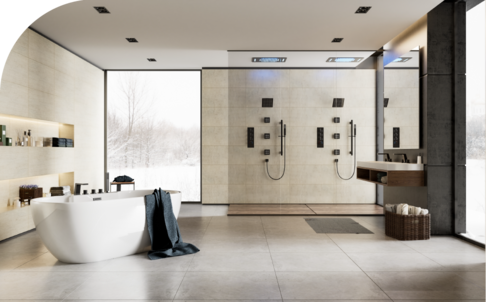
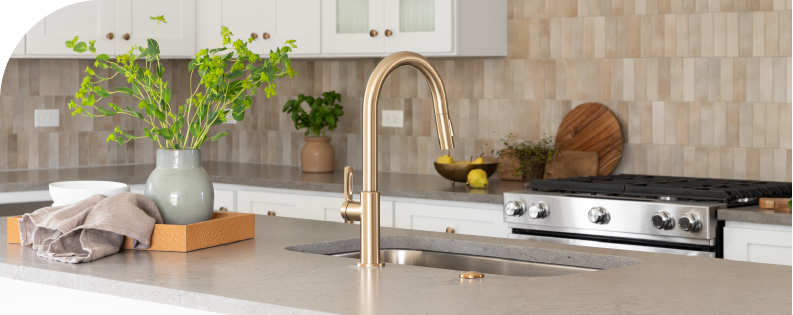


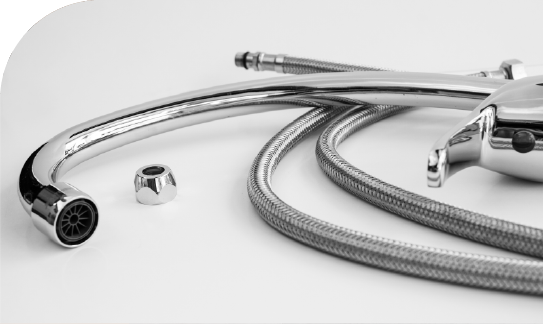

Leave a Reply